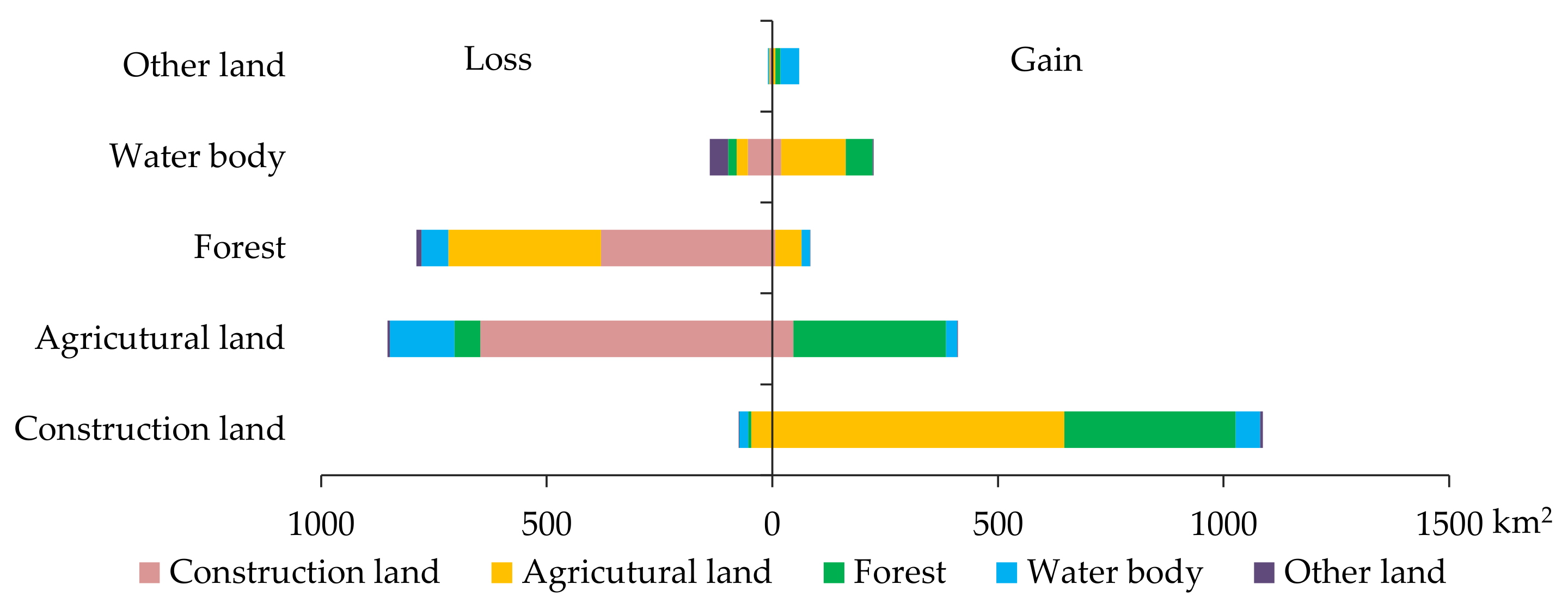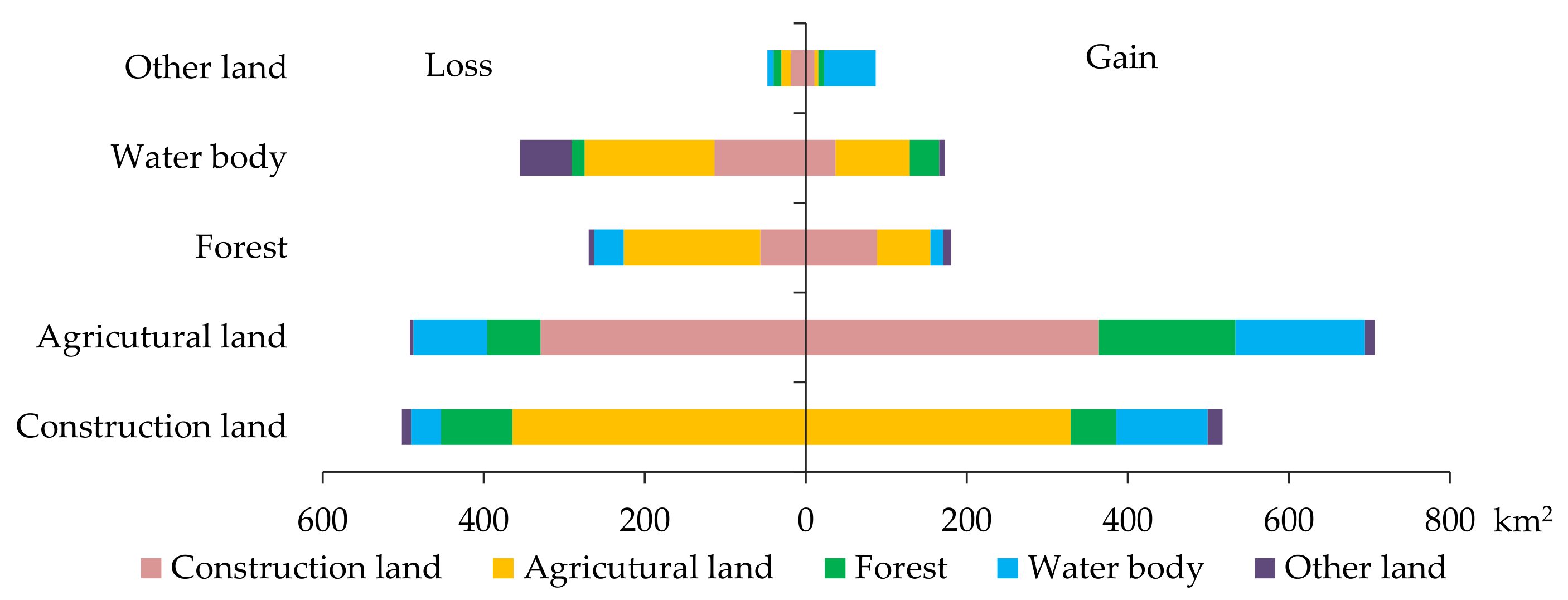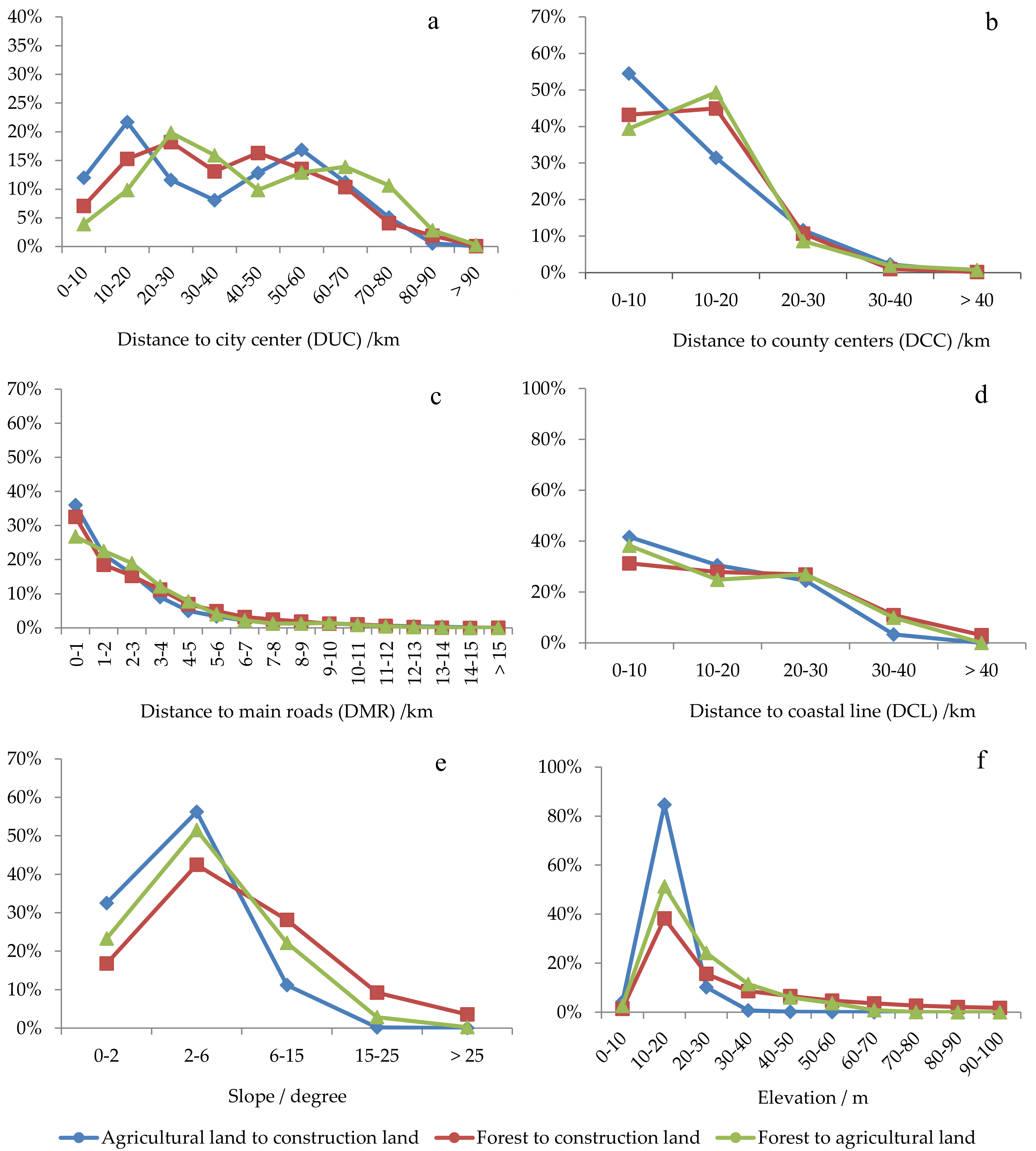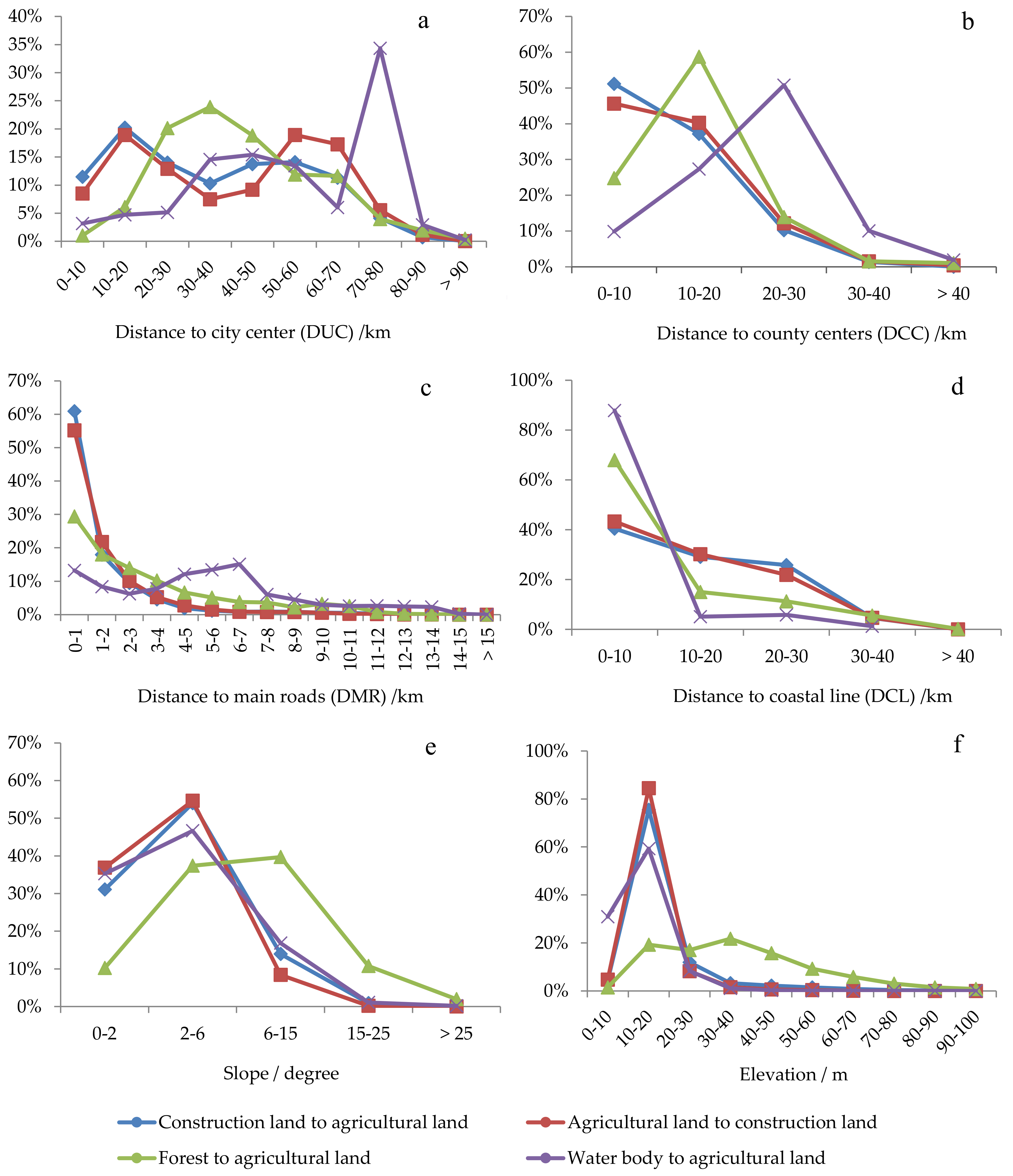Land Use Change in Coastal Cities during the Rapid Urbanization Period from 1990 to 2016: A Case Study in Ningbo City, China
Abstract
1. Introduction
2. Materials and Methods
2.1. Study Area
2.2. Data
2.3. Random Forest (RF) Classification
2.4. Land Use Transition Matrix (LUTM)
2.5. Spatial Variation Analysis
3. Results
3.1. Accuracy Assessment of RF-Derived Land Use Data
3.2. An Overall Sketch of Land Use Change
3.3. Major Types of Land Use Transitions
3.4. Spatial Variations in Major Types of Land Use Transitions by Groups of Spatial Attributes
4. Discussion
4.1. Driving Forces of Land Use Change in Ningbo City
4.2. Policy Implications for Spatial Regulations in Ningbo City
5. Conclusions
Author Contributions
Funding
Acknowledgments
Conflicts of Interest
References
- Lambin, E.F.; Turner, B.L.; Geist, H.J.; Agbola, S.B.; Angelsen, A.; Bruce, J.W.; Coomes, O.T.; Dirzo, R.; Fischer, G.; Folke, C.; et al. The causes of land-use and land-cover change: Moving beyond the myths. Glob. Environ. Chang. Hum. Policy Dimens. 2001, 11, 261–269. [Google Scholar] [CrossRef]
- Hu, Y. An Analysis of Land-Use and Land-Cover Change in the Zhujiang–Xijiang Economic Belt, China, from 1990 to 2017. Appl. Sci. 2018, 8, 1524. [Google Scholar] [CrossRef]
- Song, W.; Pijanowski, B.C.; Tayyebi, A. Urban expansion and its consumption of high-quality farmland in Beijing, China. Ecol. Indic. 2015, 54, 60–70. [Google Scholar] [CrossRef]
- Carvalho, T.S.; Domingues, E.P.; Horridge, J.M. Controlling deforestation in the Brazilian Amazon: Regional economic impacts and land-use change. Land Use Policy 2017, 64, 327–341. [Google Scholar] [CrossRef]
- Hernández, Á.; Arellano, E.C.; Morales-Moraga, D.; Miranda, M.D. Understanding the effect of three decades of land use change on soil quality and biomass productivity in a Mediterranean landscape in Chile. Catena 2016, 140, 195–204. [Google Scholar] [CrossRef]
- Habermann, M.; Billger, M.; Haeger-Eugensson, M. Land use Regression as Method to Model Air Pollution. Previous Results for Gothenburg/Sweden. Procedia Eng. 2015, 115, 21–28. [Google Scholar] [CrossRef]
- Liu, J.; Liu, M.; Deng, X.; Zhuang, D.; Zhang, Z.; Luo, D. The land use and land cover change database and its relative studies in China. J. Geogr. Sci. 2002, 12, 275–282. [Google Scholar]
- Haney, N.; Cohen, S. Predicting 21st century global agricultural land use with a spatially and temporally explicit regression-based model. Appl. Geogr. 2015, 62, 366–376. [Google Scholar] [CrossRef]
- van Vliet, J.; de Groot, H.L.F.; Rietveld, P.; Verburg, P.H. Manifestations and underlying drivers of agricultural land use change in Europe. Landsc. Urban Plan. 2015, 133, 24–36. [Google Scholar] [CrossRef]
- van Vliet, J.; Eitelberg, D.A.; Verburg, P.H. A global analysis of land take in cropland areas and production displacement from urbanization. Glob. Environ. Chang. 2017, 43, 107–115. [Google Scholar] [CrossRef]
- Pazur, R.; Lieskovsky, J.; Feranec, J.; Otahel, J. Spatial determinants of abandonment of large-scale arable lands and managed grasslands in Slovakia during the periods of post-socialist transition and European Union accession. Appl. Geogr. 2014, 54, 118–128. [Google Scholar] [CrossRef]
- Bento-Gonçalves, A.; Vieira, A.; da Vinha, L.; Hamada, S. Changes in mainland Portuguese forest areas since the last decade of the XXth century. Méditerranée 2018, 2018. [Google Scholar] [CrossRef]
- Huang, Y.; Zhang, T.; Wu, W.; Zhou, Y.; Tian, B. Rapid risk assessment of wetland degradation and loss in low-lying coastal zone of Shanghai, China. Hum. Ecol. Risk Assess. Int. J. 2016, 23, 82–97. [Google Scholar] [CrossRef]
- Wheater, H.; Evans, E. Land use, water management and future flood risk. Land Use Policy 2009, 26, S251–S264. [Google Scholar] [CrossRef]
- Muis, S.; Lin, N.; Verlaan, M.; Winsemius, H.C.; Ward, P.J.; Aerts, J. Spatiotemporal patterns of extreme sea levels along the western North-Atlantic coasts. Sci. Rep. 2019, 9, 3391. [Google Scholar] [CrossRef]
- Sado-Inamura, Y.; Fukushi, K. Empirical analysis of flood risk perception using historical data in Tokyo. Land Use Policy 2019, 82, 13–29. [Google Scholar] [CrossRef]
- Kalantari, Z.; Briel, A.; Lyon, S.W.; Olofsson, B.; Folkeson, L. On the utilization of hydrological modelling for road drainage design under climate and land use change. Sci. Total Environ. 2014, 475, 97–103. [Google Scholar] [CrossRef]
- Pan, H.; Deal, B.; Destouni, G.; Zhang, Y.; Kalantari, Z. Sociohydrology modeling for complex urban environments in support of integrated land and water resource management practices. Land Degrad. Dev. 2018, 29, 3639–3652. [Google Scholar] [CrossRef]
- Yao, H. Characterizing landuse changes in 1990–2010 in the coastal zone of Nantong, Jiangsu province, China. Ocean Coast. Manag. 2013, 71, 108–115. [Google Scholar] [CrossRef]
- Ning, J.; Liu, J.; Kuang, W.; Xu, X.; Zhang, S.; Yan, C.; Li, R.; Wu, S.; Hu, Y.; Du, G.; et al. Spatiotemporal patterns and characteristics of land-use change in China during 2010–2015. J. Geogr. Sci. 2018, 28, 547–562. [Google Scholar] [CrossRef]
- Guo, L.; Wang, D.; Qiu, J.; Wang, L.; Liu, Y. Spatio-temporal patterns of land use change along the Bohai Rim in China during 1985–2005. J. Geogr. Sci. 2009, 19, 568–576. [Google Scholar] [CrossRef]
- Yu, W.J.; Zhou, W.Q. The Spatiotemporal Pattern of Urban Expansion in China: A Comparison Study of Three Urban Megaregions. Remote Sens. 2017, 9, 45. [Google Scholar] [CrossRef]
- Gumma, M.; Mohammad, I.; Nedumaran, S.; Whitbread, A.; Lagerkvist, C. Urban Sprawl and Adverse Impacts on Agricultural Land: A Case Study on Hyderabad, India. Remote Sens. 2017, 9, 1136. [Google Scholar] [CrossRef]
- Xu, M.; He, C.Y.; Liu, Z.F.; Dou, Y.Y. How Did Urban Land Expand in China between 1992 and 2015? A Multi-Scale Landscape Analysis. PLoS ONE 2016, 11, 1136. [Google Scholar] [CrossRef]
- Wang, J.; Chen, Y.; Shao, X.; Zhang, Y.; Cao, Y. Land-use changes and policy dimension driving forces in China: Present, trend and future. Land Use Policy 2012, 29, 737–749. [Google Scholar] [CrossRef]
- Liu, Y.; Fang, F.; Li, Y. Key issues of land use in China and implications for policy making. Land Use Policy 2014, 40, 6–12. [Google Scholar] [CrossRef]
- Cheng, L.; Jiang, P.; Chen, W.; Li, M.; Wang, L.; Gong, Y.; Pian, Y.; Xia, N.; Duan, Y.; Huang, Q. Farmland protection policies and rapid urbanization in China: A case study for Changzhou City. Land Use Policy 2015, 48, 552–566. [Google Scholar]
- Zhong, T.; Huang, X.; Zhang, X.; Scott, S.; Wang, K. The effects of basic arable land protection planning in Fuyang County, Zhejiang Province, China. Appl. Geogr. 2012, 35, 422–438. [Google Scholar] [CrossRef]
- The State Council of the People’s Republic of China. Outline of National Land Planning (2016–2030). 2017. Available online: http://www.gov.cn/zhengce/content/2017-02/04/content_5165309.htm (accessed on 15 December 2018).
- The General Office of State Council. Provincial Space Planning Pilot Program. 2017. Available online: http://www.gov.cn/zhengce/2017-01/09/content_5158211.htm (accessed on 15 December 2018).
- Zhang, C.; Miao, C.; Zhang, W.; Chen, X. Spatiotemporal patterns of urban sprawl and its relationship with economic development in China during 1990–2010. Habitat Int. 2018, 79, 51–60. [Google Scholar] [CrossRef]
- Li, X.; Zhang, L.; Liang, C. A GIS-based buffer gradient analysis on spatiotemporal dynamics of urban expansion in Shanghai and its major satellite cities. Procedia Environ. Sci. 2010, 2, 1139–1156. [Google Scholar] [CrossRef]
- Sun, C.; Wu, Z.-f.; Lv, Z.-q.; Yao, N.; Wei, J.-b. Quantifying different types of urban growth and the change dynamic in Guangzhou using multi-temporal remote sensing data. Int. J. Appl. Earth Obs. Geoinf. 2013, 21, 409–417. [Google Scholar] [CrossRef]
- Chen, J.F.; Chang, K.T.; Karacsonyi, D.; Zhang, X.L. Comparing urban land expansion and its driving factors in Shenzhen and Dongguan, China. Habitat Int. 2014, 43, 61–71. [Google Scholar] [CrossRef]
- Dou, P.; Chen, Y.B. Dynamic monitoring of land-use/land-cover change and urban expansion in Shenzhen using Landsat imagery from 1988 to 2015. Int. J. Remote Sens. 2017, 38, 5388–5407. [Google Scholar] [CrossRef]
- Xu, J.; Zhao, Y.; Zhong, K.; Zhang, F.; Liu, X.; Sun, C. Measuring spatio-temporal dynamics of impervious surface in Guangzhou, China, from 1988 to 2015, using time-series Landsat imagery. Sci. Total Environ. 2018, 627, 264–281. [Google Scholar] [CrossRef]
- You, H. Agricultural landscape dynamics in response to economic transition: Comparisons between different spatial planning zones in Ningbo region, China. Land Use Policy 2017, 61, 316–328. [Google Scholar] [CrossRef]
- Kantakumar, L.N.; Kumar, S.; Schneider, K. Spatiotemporal urban expansion in Pune metropolis, India using remote sensing. Habitat Int. 2016, 51, 11–22. [Google Scholar] [CrossRef]
- Wu, W.; Zucca, C.; Karam, F.; Liu, G. Enhancing the performance of regional land cover mapping. Int. J. Appl. Earth Obs. Geoinf. 2016, 52, 422–432. [Google Scholar] [CrossRef]
- Rodriguez-Galiano, V.F.; Chica-Rivas, M. Evaluation of different machine learning methods for land cover mapping of a Mediterranean area using multi-seasonal Landsat images and Digital Terrain Models. Int. J. Digit. Earth 2012, 7, 492–509. [Google Scholar] [CrossRef]
- Rodriguez-Galiano, V.F.; Ghimire, B.; Rogan, J.; Chica-Olmo, M.; Rigol-Sanchez, J.P. An assessment of the effectiveness of a random forest classifier for land-cover classification. Isprs J. Photogramm. Remote Sens. 2012, 67, 93–104. [Google Scholar] [CrossRef]
- Cracknell, M.J.; Reading, A.M. Geological mapping using remote sensing data: A comparison of five machine learning algorithms, their response to variations in the spatial distribution of training data and the use of explicit spatial information. Comput. Geosci. 2014, 63, 22–33. [Google Scholar] [CrossRef]
- Tang, Y.T.; Chan, F.K.S.; Griffiths, J. City profile: Ningbo. Cities 2015, 42, 97–108. [Google Scholar] [CrossRef]
- Bureau of Statistics of Ningbo City, Ningbo Investigation Team of National Bureau of Statistics. Statistical Yearbook of Ningbo City; China Statistics Press: Ningbo, China, 2018. Available online: http://vod.ningbo.gov.cn:88/nbtjj/tjnj/2017nbnj/indexch.htm (accessed on 13 December 2018).
- Wikipedia, Port of Ningbo-Zhoushan. 2019. Available online: https://en.wikipedia.org/wiki/Port_of_Ningbo-Zhoushan (accessed on 21 January 2019).
- Li, J.; Zhang, Z.; Ma, L.; Gu, Q.; Wang, K.; Xu, Z. Assessment on the impact of arable land protection policies in a rapidly developing region. ISPRS Int. J. Geo-Inf. 2016, 5, 69. [Google Scholar] [CrossRef]
- Municipal Bureau of Land Resources of Ningbo. General Plan of Land Use of Ningbo City (2006–2020). 2017. Available online: http://www.nblr.gov.cn/art/2018/6/25/art_17253_2961390.html (accessed on 27 March 2018).
- Waske, B.; van der Linden, S.; Oldenburg, C.; Jakimow, B.; Rabe, A.; Hostert, P. imageRF—A user-oriented implementation for remote sensing image analysis with Random Forests. Environ. Model. Softw. 2012, 35, 192–193. [Google Scholar] [CrossRef]
- Belgiu, M.; Drăguţ, L. Random forest in remote sensing: A review of applications and future directions. ISPRS J. Photogramm. Remote Sens. 2016, 114, 24–31. [Google Scholar] [CrossRef]
- McFeeters, S.K. The use of the normalized difference water index (NDWI) in the delineation of open water features. Int. J. Remote Sens. 1996, 17, 1425–1432. [Google Scholar] [CrossRef]
- Xu, H.Q. Modification of normalised difference water index (NDWI) to enhance open water features in remotely sensed imagery. Int. J. Remote Sens. 2006, 27, 3025–3033. [Google Scholar] [CrossRef]
- Kawamura, M.; Jayamanna, S.; Tsujiko, T. Relation between social and environmental conditions in Colombo Sri Lanka and the Urban Index estimated by satellite remote sensing data. Int. Arch. Photogramm. Remote Sens. 1996, 31 Pt B7, 321–326. [Google Scholar]
- Zha, Y.; Gao, J.; Ni, S. Use of normalized difference built-up index in automatically mapping urban areas from TM imagery. Int. J. Remote Sens. 2003, 24, 583–594. [Google Scholar] [CrossRef]
- Cao, R.; Li, C.; Liu, L.; Wang, J.; Yan, G. Extracting Miyun reservoir’s water area and monitoring its change based on a revised normalized different water index. Sci. Surv. Mapp. 2008, 33, 158–160. [Google Scholar]
- Shi, G.; Jiang, N.; Yao, L.Q. Land Use and Cover Change during the Rapid Economic Growth Period from 1990 to 2010: A Case Study of Shanghai. Sustainability 2018, 10, 426. [Google Scholar] [CrossRef]
- Su, S.; Zhou, X.; Wan, C.; Li, Y.; Kong, W. Land use changes to cash crop plantations: Crop types, multilevel determinants and policy implications. Land Use Policy 2016, 50, 379–389. [Google Scholar] [CrossRef]
- Li, X.; Zhou, W.; Ouyang, Z. Forty years of urban expansion in Beijing: What is the relative importance of physical, socioeconomic, and neighborhood factors? Appl. Geogr. 2013, 38, 1–10. [Google Scholar] [CrossRef]
- Dubovyk, O.; Sliuzas, R.; Flacke, J. Spatio-temporal modelling of informal settlement development in Sancaktepe district, Istanbul, Turkey. ISPRS J. Photogramm. Remote Sens. 2011, 66, 235–246. [Google Scholar] [CrossRef]
- Pan, H.; Deal, B.; Chen, Y.; Hewings, G. A Reassessment of urban structure and land-use patterns: Distance to CBD or network-based?—Evidence from Chicago. Reg. Sci. Urban Econ. 2018, 70, 215–228. [Google Scholar] [CrossRef]
- Lunetta, R.S.; Shao, Y.; Ediriwickrema, J.; Lyon, J.G. Monitoring agricultural cropping patterns across the Laurentian Great Lakes Basin using MODIS-NDVI data. Int. J. Appl. Earth Obs. Geoinf. 2010, 12, 81–88. [Google Scholar] [CrossRef]
- Sun, T.; Deng, W.; Ma, L. Urban land use change detection based on object-oriented classification. Geogr. Inf. 2018, 16, 94–99. (In Chinese) [Google Scholar]
- Olofsson, P.; Foody, G.M.; Herold, M.; Stehman, S.V.; Woodcock, C.E.; Wulder, M.A. Good practices for estimating area and assessing accuracy of land change. Remote Sens. Environ. 2014, 148, 42–57. [Google Scholar] [CrossRef]
- Taylor, L.E.; Hurley, P.T. A Comparative Political Ecology of Exurbia: Planning, Environmental Management, and Landscape Change; Springer international publishing AG: Cham, Switzerland, 2016. [Google Scholar]
- Janečková Molnárová, K.; Skřivanová, Z.; Kalivoda, O.; Sklenička, P. Rural identity and landscape aesthetics in exurbia: Some issues to resolve from a Central European perspective. Morav. Geogr. Rep. 2017, 25, 2–12. [Google Scholar] [CrossRef]
- Gao, J.L.; Wei, Y.D.; Chen, W.; Chen, J.L. Economic transition and urban land expansion in Provincial China. Habitat Int. 2014, 44, 461–473. [Google Scholar] [CrossRef]
- Huang, Z.; Wei, Y.D.; He, C.; Li, H. Urban land expansion under economic transition in China: A multi-level modeling analysis. Habitat Int. 2015, 47, 69–82. [Google Scholar] [CrossRef]
- Cao, G.Z.; Feng, C.C.; Tao, R. Local "Land finance" in China’s urban expansion: Challenges and solutions. China World Econ. 2008, 16, 19–30. [Google Scholar] [CrossRef]
- Chen, Z.; Tang, J.; Wan, J.; Chen, Y. Promotion incentives for local officials and the expansion of urban construction land in China: Using the Yangtze River Delta as a case study. Land Use Policy 2017, 63, 214–225. [Google Scholar] [CrossRef]
- The State Council of the People’s Republic of China. Notification of the Central Committee of the Communist Party of China and the State Council of the People’s Republic of China on Strengthening Land Management and Prohibiting the Irrational Occupation of Farmland. 1986. Available online: http://www.law-lib.com/law/law_view1.asp?id=47245 (accessed on 15 December 2018).
- The Central People’s Government of the People’s Republic of China. Some Suggestions of the Central People’s Government of the People’s Republic of China and the State Council of the People’s Republic of China and the State Council of the People’s Republic of China for the policies of Promoting Farmers Income Increase; 2004. Available online: http://www.gov.cn/gongbao/content/2004/content_63144.htm (accessed on 15 December 2018).
- The General Office of State Council. The Report of Government Work of 2007; 2007. Available online: http://www.gov.cn/test/2009-03/16/content_1260188.htm (accessed on 15 December 2018).
- General Office of People’s Government of Ningbo City. Planning for Reclamation of Tidal Flat in Ningbo City (2011–2020). 2011. Available online: http://www.doc88.com/p-0012079916795.html (accessed on 15 December 2018).
- Office of the development and reform commission of Zhejiang Province. General Plan for Tidal Flat Reclamation in Zhejiang Province (2005–2020). 2006. Available online: https://wenku.baidu.com/view/d0287e1aa300a6c30c229f42.html (accessed on 15 December 2018).
- Tian, B.; Wu, W.; Yang, Z.; Zhou, Y. Drivers, trends, and potential impacts of long-term coastal reclamation in China from 1985 to 2010. Estuar. Coast. Shelf Sci. 2016, 170, 83–90. [Google Scholar] [CrossRef]
- Hatna, E.; Bakker, M.M. Abandonment and Expansion of Arable Land in Europe. Ecosystems 2011, 14, 720–731. [Google Scholar] [CrossRef]
- Huang, D.; Huang, J.; Liu, T. Delimiting urban growth boundaries using the CLUE-S model with village administrative boundaries. Land Use Policy 2019, 82, 422–435. [Google Scholar] [CrossRef]
- Hu, Y.; Kong, X.; Zheng, J.; Sun, J.; Wang, L.; Min, M. Urban Expansion and Farmland Loss in Beijing during 1980–2015. Sustainability 2018, 10, 3927. [Google Scholar] [CrossRef]
- Li, H.; Zhang, X.; Zhang, Y.; Yang, X.; Zhang, K. Risk assessment of forest landscape degradation using Bayesian network modeling in the Miyun Reservoir catchment (China) with emphasis on the Beijing-Tianjin sandstorm source control program. Land Degrad. Dev. 2018, 29, 3876–3885. [Google Scholar] [CrossRef]
- Bradshaw, C.J.A.; Sodhi, N.S.; Peh, K.S.H.; Brook, B.W. Global evidence that deforestation amplifies flood risk and severity in the developing world. Glob. Chang. Biol. 2007, 13, 2379–2395. [Google Scholar] [CrossRef]
- Chakravarty, S.; Ghosh, S.K.; Suresh, C.P.; Dey, A.N.; Shukla, G. Deforestration: Causes, effects and control strategies. In Global Perspectives on Sustainable Forest Management; IntechOpen: Rijeka, Croatia, 2012. [Google Scholar]
- Decaens, T.; Martins, M.B.; Feijoo, A.; Oszwald, J.; Doledec, S.; Mathieu, J.; Arnaud de Sartre, X.; Bonilla, D.; Brown, G.G.; Cuellar Criollo, Y.A.; et al. Biodiversity loss along a gradient of deforestation in Amazonian agricultural landscapes. Conserv. Biol. 2018, 32, 1380–1391. [Google Scholar] [CrossRef]
- Carugati, L.; Gatto, B.; Rastelli, E.; Lo Martire, M.; Coral, C.; Greco, S.; Danovaro, R. Impact of mangrove forests degradation on biodiversity and ecosystem functioning. Sci. Rep. 2018, 8, 13298. [Google Scholar] [CrossRef]
- Jiang, B.; Bai, Y.; Wong, C.P.; Xu, X.; Alatalo, J.M. China’s ecological civilization program–Implementing ecological redline policy. Land Use Policy 2019, 81, 111–114. [Google Scholar] [CrossRef]
- Meng, W.; Hu, B.; He, M.; Liu, B.; Mo, X.; Li, H.; Wang, Z.; Zhang, Y. Temporal-spatial variations and driving factors analysis of coastal reclamation in China. Estuar. Coast. Shelf Sci. 2017, 191, 39–49. [Google Scholar] [CrossRef]
- Yang, L.; Jiang, F.; Xie, Z.; Wang, J.; Liao, F.; Qi, S. Study on land reclamation around Poyang Lake in the abandoned farmland in the context of the policy for converting farmland to lake. China Land Sci. 2017, 31, 44–50. (In Chinese) [Google Scholar]
- Shen, Y.; Jia, H.; Li, C.; Tang, J. Numerical simulation of saltwater intrusion and storm surge effects of reclamation in Pearl River Estuary, China. Appl. Ocean Res. 2018, 79, 101–112. [Google Scholar] [CrossRef]
- Li, N.; Wang, Z.; Xia, L.; Yan, F.; Xu, L.-Q.; Qiao, Y.-J.; Li, X.-h.; An, S.-Q.; Fang, S.-B. Effects of long-term coastal reclamation on suitable habitat and wintering population size of the endangered Red-crowned Crane, Grus japonensis. Hydrobiologia 2017, 827, 21–29. [Google Scholar] [CrossRef]
- Gao, D.; Chen, G.; Li, X.; Lin, X.; Zeng, C. Reclamation Culture Alters Sediment Phosphorus Speciation and Ecological Risk in Coastal Zone of Southeastern China. Clean-Soil Air Water 2018, 46, 1700495. [Google Scholar] [CrossRef]
- The State Council of the People’s Republic of China. Notification of the State Council of Strengthening Coastal Wetland Protection and Strictly Control Reclamation; 2018. Available online: http://www.gov.cn/zhengce/content/2018-07/25/content_5309058.htm (accessed on 15 December 2018).
- Murray, N.J.; Phinn, S.R.; DeWitt, M.; Ferrari, R.; Johnston, R.; Lyons, M.B.; Clinton, N.; Thau, D.; Fuller, R.A. The global distribution and trajectory of tidal flats. Nature 2019, 565, 222–225. [Google Scholar] [CrossRef]









| No. | Acquisition Date | Sensor | Path/Row | Cloud Cover (%) |
|---|---|---|---|---|
| 1 | 14 August 1990 | Landsat 5 | 118/39,118/40 | 0 |
| 2 | 12 August 1995 | Landsat 5 | 118/39,118/40 | 0 |
| 3 | 18 September 2000 | Landsat 7 | 118/39,118/40 | 0 |
| 4 | 30 July 2005 | Landsat 7 | 118/39 | 2 |
| 5 | 15 August 2005 | Landsat 7 | 118/39 | 0 |
| 6 | 19 September 2006 | Landsat 7 | 118/40 | 0 |
| 7 | 04 June 2005 | Landsat 5 | 118/40 | 4 |
| 8 | 17 July 2009 | Landsat 5 | 118/39 | 0 |
| 9 | 20 July 2010 | Landsat 5 | 118/40 | 20 |
| 10 | 20 July 2016 | Landsat 8 | 118/39 | 1 |
| 11 | 28 July 2016 | Landsat 7 | 118/40 | 3 |
| Code | Land Use Type | Description |
|---|---|---|
| 1 | Construction land | Land covered by construction, including urban or rural residential land, industrial areas, commercial areas, transportation facility areas, etc. |
| 2 | Agricultural land | Land for growing crops, also called cultivated land or arable land in other studies |
| 3 | Forest | Land for growing trees, shrubs, and bamboo, as well as coastal mangrove forest |
| 4 | Water body | Rivers, lakes, sea areas, ponds, reservoirs, etc. |
| 5 | Other land | Other types of land use, including unused land |
| Year | This Study | You’s Study | ||
|---|---|---|---|---|
| OA (%) | Kappa | OA (%) | Kappa | |
| 1990 | 87.8 | 0.83 | 92.5 1 | 0.89 1 |
| 1995 | 91.6 | 0.88 | 94.1 | 0.92 |
| 2000 | 92.8 | 0.90 | 91.7 | 0.89 |
| 2005 | 85.5 | 0.81 | 93.6 | 0.91 |
| 2010 | 88.8 | 0.85 | 93.9 | 0.91 |
| 2016 | 86.8 | 0.83 | -- | -- |
| Year | Construction Land | Agricultural Land | Forest | Water Body | Other Land | |||||
|---|---|---|---|---|---|---|---|---|---|---|
| Area (km2) | Percentage (%) | Area (km2) | Percentage (%) | Area (km2) | Percentage (%) | Area (km2) | Percentage (%) | Area (km2) | Percentage (%) | |
| 1990 | 531.51 | 5.71 | 2515.91 | 27.02 | 5351.24 | 57.46 | 903.2 | 9.70 | 10.85 | 0.12 |
| 1995 | 992.97 | 10.66 | 2519.41 | 27.05 | 4861.08 | 52.20 | 923.62 | 9.92 | 15.61 | 0.17 |
| 2000 | 1200.56 | 12.89 | 2238.68 | 24.04 | 4756.77 | 51.08 | 1052.1 | 11.30 | 64.59 | 0.69 |
| 2005 | 1543.87 | 16.58 | 2074.25 | 22.27 | 4646.15 | 49.89 | 988.31 | 10.61 | 60.11 | 0.65 |
| 2010 | 1515.4 | 16.27 | 2119.07 | 22.75 | 4662.69 | 50.07 | 881.33 | 9.46 | 134.22 | 1.44 |
| 2016 | 1560.15 | 16.75 | 2289.27 | 24.58 | 4557.1 | 48.93 | 806.55 | 8.66 | 99.62 | 1.07 |
© 2019 by the authors. Licensee MDPI, Basel, Switzerland. This article is an open access article distributed under the terms and conditions of the Creative Commons Attribution (CC BY) license (http://creativecommons.org/licenses/by/4.0/).
Share and Cite
Zhang, C.; Zhong, S.; Wang, X.; Shen, L.; Liu, L.; Liu, Y. Land Use Change in Coastal Cities during the Rapid Urbanization Period from 1990 to 2016: A Case Study in Ningbo City, China. Sustainability 2019, 11, 2122. https://doi.org/10.3390/su11072122
Zhang C, Zhong S, Wang X, Shen L, Liu L, Liu Y. Land Use Change in Coastal Cities during the Rapid Urbanization Period from 1990 to 2016: A Case Study in Ningbo City, China. Sustainability. 2019; 11(7):2122. https://doi.org/10.3390/su11072122
Chicago/Turabian StyleZhang, Chao, Shuai Zhong, Xue Wang, Lei Shen, Litao Liu, and Yujie Liu. 2019. "Land Use Change in Coastal Cities during the Rapid Urbanization Period from 1990 to 2016: A Case Study in Ningbo City, China" Sustainability 11, no. 7: 2122. https://doi.org/10.3390/su11072122
APA StyleZhang, C., Zhong, S., Wang, X., Shen, L., Liu, L., & Liu, Y. (2019). Land Use Change in Coastal Cities during the Rapid Urbanization Period from 1990 to 2016: A Case Study in Ningbo City, China. Sustainability, 11(7), 2122. https://doi.org/10.3390/su11072122








